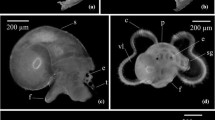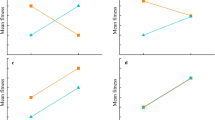Abstract
We conducted laboratory studies on the ontogenetic behavior of free embryos (first life interval after hatching) and larvae (first feeding interval) of pallid and shovelnose sturgeon. Migration styles of both species were similar for timing of migration (initiation by embryos on day 0 after hatching and cessation by larvae on days 12–13 at 236–243 cumulative temperature degree units), migration distance (about 13 km), life interval when most distance was moved (embryo), and diel behavior of embryos (diurnal). However, the species differed for two behaviors: movement characteristics of embryos (peak movement rate of pallid sturgeon was only one-half the peak rate of shovelnose sturgeon, but pallid sturgeon continued the lower rate for twice as long) and diel behavior of larvae (pallid sturgeon were diurnal and shovelnose sturgeon were nocturnal). Thus, the species used different methods to move the same distance. Migrating as poorly developed embryos suggests a migration style to avoid predation at the spawning site, but moving from spawning habitat to rearing habitat before first feeding could also be important. Migrants of both species preferred bright habitat (high illumination intensity and white substrate), a behavioral preference that may characterize the migrants of many species of sturgeon. Both species were remarkably similar for swimming height above the bottom by age, and day 7 and older migrants may swim far above the bottom and move far downstream. A migration of 12 or 13 days will probably not distribute larvae throughout the population's range, so an older life interval likely initiates a second longer downstream migration (2-step migration). By day 2, individuals of both species were a black-tail phenotype (light grey body with a black-tail that moved conspicuously during swimming). Aggregation behavior suggests that black-tail is a visual signal used for group cohesion.
Similar content being viewed by others
References cited
Baerends, G.P. & J.M. Baerends-van Roon. 1950. An introduction to the study ofcichlid fishes. Behav. Suppl. 1: 1–242.
Balon, E. 1999. Alternative ways to become a juvenile or adefinitive phenotype (and on some persisting linguistic offenses). Env. Biol. Fish. 56: 17–38.
Bruton, M.1990. The conservation of alternative life-history styles: a conclusion to the second ALHS volume. Env. Biol. Fish. 28: 309–313.
Buckley, J.L. & B. Kynard. 1981. Spawning and rearing of shortnose sturgeon from the Connecticut River. Prog. Fish. Cult. 43: 74–76.
Carlson, D.M., W.L. Pflieger, L. Trial & P.S. Haverland. 1985. Distribution, biology and hybridization of Scaphirhynchus albus and S. platorynchus in the Missouri and Mississippi rivers. Env. Biol. Fish. 14: 51–59.
Deng, Zhlonglin & Y. Xu. 1989. Analysis on Acipenser sinensis spawning grounds and spawning scales below Gezhouba hydro-electric dam by means of examining the digestive contents of benthic fishes. pp. 243–250. In: Proc. 2nd Internat. Sturgeon Symposium, Bordeaux.
Gisbert, E., P. Williot & F. Castello-Orvay. 1999. Behavioural modifications in the early life stages of Siberian sturgeon (Acipenser baerii, Brandt). J. Appl. Ichthyol. 15: 237–242.
Guthrie, D.M. 1986. Role of vision in fish behavior. pp. 75–113. In:T.J. Pitcher (ed.) The Behaviour of Teleost Fishes, The Johns Hopkins University Press, Baltimore.
Guthrie, D.M. & W.R.A. Muntz. 1993. Role of vision in fish behavior. pp. 89–128. In: T.J. Pitcher (ed.) Behaviour of Teleost Fishes, Second Edition, Chapman & Hall, London.
June, F.C. 1977. Reproduction patterns in seventeen species of warmwater fishes in a Missouri River reservoir. Env. Biol. Fish. 2: 285–296.
Kallemeyn, I. 1983. Status of the pallid sturgeon. Fisheries 8: 3–9.
Keenlyne, K.D., E.M. Grossman & L.G. Jenkins. 1992. Fecundity of pallid sturgeon. Trans. Amer. Fish. Soc. 121: 139–140.
Keenlyne, K.D., C.J. Henry, A. Tews & P. Clancey. 1994. Morphological comparisons of upper Missouri River sturgeons. Trans. Amer. Fish. Soc. 123: 779–785.
Keenleyside, M.H.A. 1955. Some aspects of schooling in fish. Behav. 8: 183–249.
Kynard, B. 1997. Life history, latitudinal patterns, and status of shortnose sturgeon, Acipenser brevirostrum. Env. Biol. Fish. 48: 319–334.
Kynard, B. & M. Horgan. 2002. Ontogenetic behavior and migration of Atlantic sturgeon, Acipenser oxyrinchus oxyrinchus, and shortnose sturgeon, A. brevirostrum, with notes on social behavior. Env. Biol. Fish. 63: 137–150.
Kynard, B., M. Horgan, M. Kieffer & D. Seibel. 2000. Habitats used by shortnose sturgeon in two Massachusetts rivers, with notes on estuarine Atlantic sturgeon: a hierarchical approach. Trans. Amer. Fish. Soc. 129: 487–503.
Lowe, E.R. & A.J. Sillman. 1993. Age-related changes in the visual pigments of the white sturgeon (Acipenser transmontanus). Can. J. Zool. 71: 1552–1557.
McLennan, D.A. 1999. A phylogenetic approach to the evolution of fish behaviour. Rev. Fish Biol. & Fish. 4: 430–460.
Moos, R.E. 1978. Movement and reproduction of shovelnose sturgeon, Scaphirynchus platorynchus, in the Missouri River, South Dakota. Ph.D. Dissertation, University of South Dakota, Vermillion. 216 pp.
Morrow, Jr. J.V., J.P. Kirk, K.J. Killgore & S.G. George. 1998. Age, growth and mortality of shovelnose sturgeon in the lower Mississippi River. N. Amer. J. Fish. Manag. 18: 725–730.
Pavlov, D.S. 1994. The downstream migration of young fishes in rivers: mechanisms and distribution. Folia Zool. 43: 193–208.
Phelps, S.R. & F.W. Allendorf. 1983. Genetic identity of pallid and shovelnose sturgeon (Scaphirhynchus albus and S. platorynchus). Copeia 1983: 696–700.
Pitcher, T.J. 1986. Functions of shoaling behaviour in teleosts. pp. 294–339. In: T.J. Pitcher (ed.) The Behaviour of Teleost Fishes, The Johns Hopkins University Press, Baltimore.
Richmond, A. & B. Kynard. 1995. Ontogenetic behavior of shortnose sturgeon. Copeia 1995: 172–182.
Sillman, A.J., C.J. O'Leary, C.D. Tarantino & E.R. Lowe. 1999. The photoreceptors and visual pigments of two species of Acipenseriformes, the shovelnose sturgeon (Scaphirhynchus platorynchus) and the paddlefish (Polyodon spathula). J. Comp. Physiol. A 184: 37–47.
Tayssedre, C. & P. Moller. 1983. The optomotor response in weakly electrical fish. Z. Tierpsychol. 60: 265–352.
Zhuang, P. 1999. Ontogenetic behavior of sturgeons (Acipenseridae) with comments on evolutionary and practical significance. Ph.D. Dissertation, Institute of Hydrobiology, Wuhan. 147 pp. (in Chinese).
Author information
Authors and Affiliations
Rights and permissions
About this article
Cite this article
Kynard, B., Henyey, E. & Horgan, M. Ontogenetic Behavior, Migration, and Social Behavior of Pallid Sturgeon, Scaphirhynchus albus, and Shovelnose Sturgeon, S. platorynchus, with Notes on the Adaptive Significance of Body Color. Environmental Biology of Fishes 63, 389–403 (2002). https://doi.org/10.1023/A:1014950202783
Issue Date:
DOI: https://doi.org/10.1023/A:1014950202783




